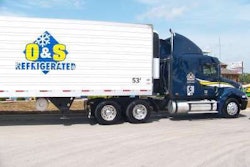Dropping equipment weight can boost revenue, increase utilization, save fuel or just offset heavier components. How do you weigh the benefits?
Ron Szapacs, maintenance specialist for power vehicles with Air Products, has done the math: According to his calculations, North American Class 8 tractor-trailers will have gained about 2,000 pounds from before the advent of the U.S. Environmental Protection Agency’s phased emissions regulations in 2003 through introduction of the 2010 engines. Estimates for 2010 tractors equipped with selective catalytic reduction (SCR) emissions technology vary, but it would appear that 350 to 400 pounds of that 2,000 pounds is coming next year.
Bruce Stockton, Con-Way Truckload’s vice president of maintenance and asset management, says his company has been testing a tractor retrofitted with SCR components. “It’s got a 30-gallon DEF (diesel exhaust fluid) tank, and we’re getting improved fuel economy out of the vehicle,” Stockton says. “But it did gain 1,000 pounds in component weight compared to its weight before it was retrofitted.”
For bulk applications, weight always has been a priority as every pound you take off the empty truck is a potential pound of revenue. But even dry and refrigerated van fleet owners who are paid on a per-mile basis rather than per pound may see value in saving weight.
Carrying more freight per load – especially in a dense lane – might give carriers a competitive edge in attracting and retaining customers. That is the approach Springfield, Mo.-based O&S Trucking has taken with an initiative called the MegaTruck, which is a low-weight tractor-trailer spec the company is beginning to offer selected customers based on volume and freight lane density.
Many van carriers see little advantage to investing in higher payloads since the logical consequence is fewer loads. That’s an outdated mindset, says Rick Johnson, chief operating officer for O&S Trucking. If you don’t compete on value – as with the MegaTruck initiative – you will just be competing on price anyway and, therefore, give up margin. (For more on O&S Trucking’s MegaTruck initiative, see “Innovators,” page 39.)
Competitive necessity is the value proposition at Napa, Calif.-based Biagi Bros., which operates more than 300 tractors and more than 700 trailers. Many Biagi Bros. customers are pushing for ever-heavier loads, says Gregg Stumbaugh, corporate equipment director.
“It’s all predicated by the demands of our customers,” Stumbaugh says. “They want to maximize the amount of product coming out of the brewery or winery.”
Some shippers insist on 50,000-pound loads and are pushing for 51,000 pounds, Stumbaugh says. So far, Biagi Bros. has been able to get the job done focusing almost exclusively on the tractor by using short, setback- axle daycabs with single exhausts, single fuel tanks and 13-liter engines, he says. Stumbaugh also is testing a few tractors with wide-base single tires. But the weight-loss challenge, which began before the 2002 round of emissions regulations, continues and soon will move to the trailers.
But even if you can’t push the envelope on payload, you can benefit from lower weight in the form of lower fuel costs. The effect is small relative to factors such as aerodynamics and rolling resistance, but last year’s escalation in diesel prices in particular got the attention of some fleet operations. Today’s diesel prices are still less than half of the peak, significantly reducing the fuel-saving benefits of lower weight. But most observers believe that the long-term trend is still toward higher prices.
Unfortunately, the goal for many fleets today isn’t really how to create additional capacity for more freight or lighten up to save fuel. Instead, the challenge is finding offsets to governmental and other forces that are making trucks and trailers even heavier.
Unforeseen weight
It seems that every new generation of emissions-compliant engines has added more payload-robbing components to the equation. “Some of that weight was unforeseen,” says Szapacs, who chaired the Technology and Maintenance Council’s S.3 engine study group from 2004 until 2008. “The increased underhood temperatures led to larger cooling systems because they were dumping exhaust gas back through the engine and overheating everything, which led to bigger fan drives and similar components.”
And that was on top of the diesel exhaust catalysts, DEF tanks, DEF itself, exhaust gas recirculation (EGR) components, diesel particulate filters, auxiliary power units and other systems mandated by EPA to meet emissions regulations. All told, these components added up to Szapacs’ 2,000-pound weight gain figure.
“We just don’t see a way around adding that weight or a way to cut weight in other places,” Stockton says. Con-way Truckload has trimmed its wheelbases and tractor-to-trailer gap “as close as we can get and still be able to move freight,” he says. “And the only way we can reduce any more weight is with the trailer.”
APUs, which have grown in popularity over the past several years as diesel prices surged, also can add a few hundred pounds to a truck. Not wanting to penalize fleets for saving fuel, Congress authorized a 400-pound weight exemption for APUs, but not all states have accepted it. Moreover, pending regulations in California soon will mandate additional aerodynamic devices on trailers, which will add still more weight. (See “The Golden State Rules,” CCJ December 2008.)
“It becomes more of a challenge every time a new set of government regulations comes into play,” Stockton says.
Michael McDonald, Linde North America’s national fleet maintenance and engineering manager, also sees weight reduction as a never-ending battle and would like to see the government acknowledge the industry’s efforts in some way. “We have done so much in the cryogenic industry to cut weight,” he says. McDonald says Linde, Air Products, Praxair and others have been on the leading edge of incorporating advanced warning systems such as roll stability, lane departure and forward-vehicle collision.
“We’ve done a lot of things to make the vehicles safer, and as a result, trucks are much safer today than they were 20 years ago,” McDonald says. “But we’re still limited to hauling 80,000 pounds.” McDonald believes that an appropriate “thank you” from the federal government for safety enhancements would be the ability to bump GVWR weight up slightly to 84,000 or even 90,000 pounds.
The numbers game
The financial benefits to saving weight are most compelling for bulk operations, of course. “We’re hauling our own product,” McDonald says. “So we’re really not charging for the trucking, per se. We’re charging for the product. And the more product we can get on the trucks and deliver on each trip, the lower our transportation costs that are built into the product.” If Linde’s trucks are more efficient, that lowers the product’s cost for the Murray Hill, N.J.-based company’s customers, he says.
Attention to maximizing payload helps Linde contain the costs for products like hospital-grade oxygen, nitrogen for food freezing and carbon dioxide. But to do that, McDonald has to look at his operations from a higher viewpoint than simply cutting weight from tractors and trailers; he has to tweak his fleet’s operations and fine-tune how it interacts with customers.
“They’re going to get their product at the lowest cost we can deliver if we can get a little more in the trailer every time,” he says. “So our goal is to watch the tank levels of the customer and make sure we don’t go out to fill a tank until we know they can hold an entire transport-tanker full, and that way we don’t bring any product back.”
Still, the simplest way to figure a payback is on the basis of revenue per unit. “Every pound of product we put on the trailer, we get paid for,” says Air Products’ Szapacs. “And every pound of weight we can take off the trucks, we can replace with payload. We look at everything, and we put a dollar value to it when we’re cutting weight.”
Szapacs says that his research over the years has led him to figure that every pound of weight shaved off a tractor or trailer is worth $10 to Air Products in enhanced cargo-carrying capacity. Suppose, for example, that an air dryer system with aluminum tanks costs $500 more than a standard system but weighs 65 pounds less, Szapacs says. Eliminating that 65 pounds is worth $650 to Air Products. “We have a net gain of $150 due to the weight we cut from the truck,” Szapacs says.
McDonald says fleets have to analyze everything and make sure they’re not hurting themselves on warranty and that they’re not going to face reliability issues by replacing a part. “Luckily, most of these products we’re looking at are proven technology from reputable manufacturers, and you don’t have a lot of issues in terms of durability,” he says. “If it’s less than $5 a pound to cut the weight off, it’s kind of a no-brainer, and we do it. If it costs a little more, we analyze it, with about $6 being the edge of what I’m willing to save to cut weight.”
Durability worries have made Biagi Bros. cautious about trying to take weight out of the trailer, Stumbaugh says. “Our issue is getting trailers that are light enough and durable enough to live through the lifecycle we expect – eight to 10 years.” So far, the carrier still uses dual tires and steel wheels on trailers as well as wood floors, for example.
“When you give up too much weight, you are going to give up integrity,” Stumbaugh says. This really becomes a worry during loading and unloading when you have two pallets weighing 1,600 pounds apiece being carried by a forklift weighing about 6,500 pounds, he says.
And fleet managers need to follow equipment pricing closely. Michael Jeffress, vice president of maintenance for Maverick Transportation, says the Little Rock, Ark.-based company has seen a 2 to 4 percent annual increase in acquisition costs for tractors and trailers. “When we break that down by component, some years we have seen the lightweight products affect the price more significantly than in other years,” Jeffress says. “Lightweight equipment can be extremely expensive.”
Unexpected directions
Stockton has found that focusing on weight savings can lead toward unexpected directions and ultimately save his company money in unanticipated ways. Con-Way Truckload – then CFI – first began shaving weight off tractors in 2002 in preparation for upcoming EPA regulations. “We tried to stay away from custom-engineered parts and just really look at the basics of the truck,” Stockton says. The Joplin, Mo.-based company would put new trucks under the microscope, having technicians, managers, dealers and drivers go over the vehicle and look for ways to save weight.
The team started by identifying components that weren’t necessary before going on to find components that could be replaced with lighter alternatives. “Not surprisingly, the drivers came up with more ideas than anybody, since they’re in the truck every day,” Stockton says.
One key suggestion made by drivers concerned the company’s fuel tank specifications. Con-Way Truckload traditionally spec’d a 120-gallon tank on each side of the tractor for a total fuel capacity of 240 gallons. But one of the drivers pulled Stockton aside and asked him if they really needed that much fuel. “He told me his average fill-up was between 80 and 100 gallons,” Stockton says. “So we went and checked our records, and sure enough, our average fill per stop was about 100 gallons or less, and our maximum fill was 120 gallons. We were carrying around extra weight and larger fuel tanks that we didn’t need.”
Acting on this discovery, Stockton immediately changed Con-Way Truckload’s fuel tank spec to 100-gallon tanks on each side of the truck. “That saved us about 386 pounds – most of that being fuel that we were no longer taking for a ride,” he says. The company also saved a little extra cash on the tanks when it spec’d the truck – about $50.
Weight savings can benefit a company’s bottom line in other ways, as Stockton has discovered. Con-way Truckload calculates that every 1,000 pounds of weight saved cuts fuel costs by about a half of a percent. “That doesn’t sound like much,” Stockton says. “When you multiply that amount by 3,000 trucks running 10,000 miles a month, it becomes a big number in a hurry.”
For Con-Way Truckload’s dry van fleet, weight savings alone haven’t been a savior in terms of operating costs, but they have helped the company maintain its previous operating cost levels and have staved off any increased costs in the face of federally mandated emissions components. “Most of the time, the rates we charge are unfortunately dictated too much by capacity in the market,” Stockton says. “But what we were able to do was keep that weight down from October 2002 to January 2010 so that we could still haul 46,500 pounds for our customers.”
Weight obsession
Stockton believes that cutting weight requires a willingness to challenge accepted practices or conventions. “We took aerodynamic chassis fairings off our tractors, which eliminated about 260 pounds and took a considerable cost off the truck,” he says. Surprisingly, fuel mileage also improved, Stockton says. “We think that was because the weight was off and it didn’t negatively affect the aerodynamics that much – or enough to make a difference,” he says. “So it kind of goes against what the aerodynamics experts tell us. But this was a real truck in real-world conditions with side winds, head winds, all kinds of weather and all kinds of freight.”
Con-way Truckload still believes that limited skirting on a truck or a trailer is the best option for improving fuel mileage, Stockton says. “And when you improve your fuel mileage, you improve your emissions, and that’s what it’s really all about.”
Resisting the “big engine” bug was Szapacs’ way of cutting another 800 pounds from his trucks. “We’re running 350-horsepower 12- and 13-liter engines,” he says. “We don’t spec 15-liter engines.” When asked if drivers complain about performance, Szapacs says torque is what a driver perceives as power.
“Torque is what pulls you up over a hill,” he says. “If you can spec a 13-liter engine with 1,550 foot-pounds of torque and instead opt for a 15-liter engine that still has 1,550 pounds of torque, what did you gain? A little acceleration – and that’s what horsepower is, acceleration. We use the smaller-liter engine, and we try and spec for peak torque.”
McDonald is a big believer in wide-base singles – and not just due to weight savings. The traction value is significantly better, as is roll stability, he says. Concentrated load per square inch is less. And rolling resistance is lower, boosting fuel mileage, McDonald says. “So there are a lot of safety enhancements in addition to the fact that you pick up about 400 pounds on the tractor and 400 pounds on the trailer going to those tires.”
For fleet managers, once weight spec’ing becomes part of the routine, it may become an obsession. McDonald has changed steering gears to save five pounds. “If I can find a way to carve five pounds off a truck, I’m ecstatic,” he says. McDonald also has saved 58 pounds by switching to nonsuspension passenger seats, and is working to convince his team drivers that they don’t need a month’s worth of canned food in their sleepers.
Stockton quit spec’ing stainless-steel quarter fenders to save 55 pounds and $130 a truck, and he managed to knock 2,000 pounds off dry-van trailer weights by spec’ing wide-base tires and switching to a composite floor material with a thinner laminate that is stronger and lasts longer. “But it costs more,” he says. “So we increased our costs, but we cut our weight. We think it’s worth it.”
“I’ve changed dolly leg suppliers on my trailers just to save 50 pounds,” Szapacs says with a laugh. “It becomes something of an obsession. But we’re delivering our products efficiently and safely, and we’ve seen no penalty in terms of maintenance or reliability by going with lighter-weight components.”
There are any number of ways to reduce weight – even down to managing drivers’ belongings. It all comes down to how obsessed you want to be.
– Avery Vise contributed to this article.
Lower weight means less energy
Fuel savings are part of the payback
Assuming today’s diesel prices, reduced fuel use alone likely won’t justify an aggressive effort to shed pounds from your truck and trailer specifications. But the money you can save on fuel certainly can help add to a return on investment justified by other factors, such as increasing or preserving payload.
Springfield, Mo.-based refrigerated truckload carrier O&S Trucking, which has worked over the past couple of years to increase payload through lower vehicle weight, recognizes the fuel economy benefits and uses the following formula to calculate the effect:
(Avg. price of fuel X Miles per truck per year X TMC fuel improvement factor
(per pound) X Desired payback in years)













